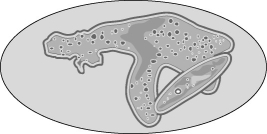Multiple Choice
You are given five test tubes, each containing an unknown protist, and your task is to read the following description and match these five protists to the correct test tube.
In test tube 1, you observe an organism feeding. Your sketch of the organism looks very similar to Figure 28.1. When light, especially red and blue light, is shone on the tubes, oxygen bubbles accumulate on the inside of test tubes 2 and 3. Chemical analysis of test tube 3 indicates the presence of substantial amounts of silica. Chemical analysis of test tube 2 indicates the presence of a chemical that is toxic to fish and humans. Microscopic analysis of organisms in test tubes 2, 4, and 5 reveals the presence of permanent, membrane-bounded sacs just under the plasma membrane. Microscopic analysis of organisms in test tube 4 reveals the presence of an apicoplast in each. Microscopic analysis of the contents in test tube 5 reveals the presence of one large nucleus and several small nuclei in each organism.

Figure 28.1
-Test tube 2 contains
A) Paramecium.
B) Navicula (diatom) .
C) Pfiesteria (dinoflagellate) .
D) Entamoeba.
E) Plasmodium.
Correct Answer:

Verified
Correct Answer:
Verified
Q1: According to the endosymbiotic theory of the
Q2: An individual mixotroph loses its plastids, yet
Q4: Similar to most amoebozoans, the forams and
Q5: A large seaweed that floats freely on
Q6: What must occur for asexual reproduction to
Q7: Which of the following are actual mutualistic
Q8: Green algae differ from land plants in
Q9: A crucial photosynthetic gene of the cyanobacterium
Q10: You are designing an artificial drug-delivery "cell"
Q11: You are given five test tubes, each